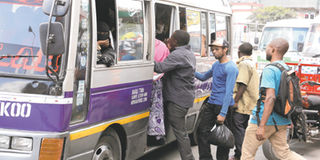The cheap urban necessity in our big city: Daladalas

Passengers rushing to climb on the Kawe to Kariakoo daladala athe Fire station.
What you need to know:
In the first feature article of series, we explore the sense of travelling in a daladala, having either to squeeze in or rush to get a seat. Many commuters solely rely on the informal daladala transit.
Latifa Mapembe knows the feeling of a packed daladala all too well. The scrambling for seats and the sudden difficulty to find space for the feet are among her morning rituals.
When she leaves her home in Mbuyuni, Dar es Salaam, around 5:30 in the morning, she prepares herself to stand up for one and a half hours in the daladala to Makumbusho bus stand before she boards another bus to Mwananyamala. Although the distance is only 14 kilometres, it can take her up to three hours to get from her home to work.
“Daladala is my only mode of transport, but sometimes it is very challenging. I can be very tired when I reach work. In the evening I sometimes leave work at 6pm and reach home at 8 or 9pm. The Bagamoyo Road has so much traffic and when I reach home I just want to eat and then sleep,” says 26-year-old Latifa who works at the Human Resource (HR) department at a microfinance company in Mwananyamala.
Latifa is among the many thousands who depend on the daladala for their daily commute. According to research by Professor David Mfinanga from University of Dar es Salaam who is a co-author of the book ‘Paratransit in African countries’ from last year, Dar es Salaam’s daladalas carry around 1.4 million people around the city every day. Most of the daladalas are old and in poor shape, but they represent a kind of public transport system that dominates in all African countries, being it a Matatu in Kenya or a Tro-Tro in Ghana.
The daladala is here to stay
The introduction of the city’s new blue buses, branded as DART, Dar es Salaam Rapid Transit, has changed the face of public transport in Dar es Salaam, but according to Professor Mfinanga it is not likely to rule out the daladala.
“The daladala will continue to be around for some time although all major routes are planned to have BRT, but 70 per cent of Dar es Salaam is unplanned settlement and most of it doesn’t have public transport routes, because it’s very difficult to plan. So I think that the daladala will continue for a long time,” Professor Mfinanga says.
For now, the daladala and the DART run side by side along Morogoro Road and Kawawa Road, but the plan is to phase out the daladala buses once the big blue buses have proven capable of servicing all the commuters along the routes. The daladala owners will be told to find other routes off the BRT lanes, Director of Road Transport Regulation at Surface and Marine Transport Regulatory Authority, Mr. Johansen Kahatano, told Sound Living.
“Once the system is stabilised, we’ll tell them to take another route,” he said and explained that the daladala owners were given money as compensation upon the start of DART. But although the daladala buses won’t carry commuters along the main roads, there will still be use of them as feeder buses along smaller roads, Mr. Kahatano further said.
Professor Mfinanga is of a similar view and emphasises that the informal fleet of colourful buses will stay in Tanzania.
“Once they are pushed out of the BRT corridor, they will move to other areas. And also, the daladalas that will be pushed out of Dar es Salaam will be moved to other routes and cities upcountry, so we will have daladalas around for many years to come,” he says.
Finding new routes
Among the people who earn a living from daladala business along Morogoro Road in Dar es Salaam is 20-year-old Emmanuel. He is a conductor on a bus between Kariokoo and Mawasiliano terminal, and has been so for the past one and a half years. There are fewer customers these days, he explains as he waits for passengers to board the bus. Emmanuel and the driver have been told that by the end of October they have to find a different route. Emmanuel hopes that he will be able to continue his work as a conductor, so he won’t have to stay at home in Manzese all the time.
After Emmanuel’s bus has departed one of the bigger UDA (Usafiri Dar es Salaam) buses enters the terminal. Its conductor Ramadhani jumps out and starts to yell “Posta! Manzese, Magomeni, Fire, Posta!”. He is 26-years-old, but has worked as both conductor and driver for more than ten years, and he has not yet experienced a decline in passengers. On the contrary, he thinks it is a good business. “It is still good, the only challenge is that it is a private bus,” he says. He explains that they can earn Sh350,000 from ticket fares on a regular day, but Sh200,000 of it goes to the bus owner, and the remaining Sh150,000 is divided among four workers and fuel. “But Sh20,000 per day is not bad,” Ramadhani says about his daily salary, and adds that he will like to continue this work for many years to come.
Most of the daladalas are owned by individuals, with the majority owning only one bus. The driver then hires the bus for a certain amount per day, and he and the conductor will try to make as much as possible for themselves during the day.
Too late for work
The drivers and conductors rely on the passengers’ fares to earn their daily income, but the passengers also rely on the daladala buses to help them reach work, school and home. It can turn out as a mutually beneficial deal or a frustrating couple of hours in the city’s traffic jam.
35-year-old Shabani Saidi uses the daladala daily to commute between his home in Mabibo and his work. He works as a supplier of cakes and bread in Gongo la Mboto on the outskirts of the city. He wakes up at 5am to catch the bus at 6am, but if the traffic is heavy he risks reaching work too late.
“My boss can be angry and asks ‘Why are you late?’ I am afraid that if I get there too late, I will lose my job,” Shabani says.
Although the daladala is stuck in traffic and often so full that Shabani has to stand up during the entire commute, it also helps him because of its low fare, he explains.
Professor Mfinanga from University of Dar es Salaam makes a similar point as he explains that the kind of informal transit that daladala represents is very convenient in an unplanned city.
“The daladala is not desirable, but it is a convenient way of transporting people in the city. They are not subsidised, they come at any time, whenever I need one. It is convenient, they offer low quality public transport, but they are also cheap,” Professor Mfinanga says.
Until 1983 the public company Usafiri Dar es Salaam, UDA, used to run all public transport buses, but after poor management, inefficiency and a lack of funds to support management of the buses, it collapsed and the government opened the market for private companies and individuals. The privately owned buses, that became known as daladala, soon became the primary choice for commuters.
[email protected]


